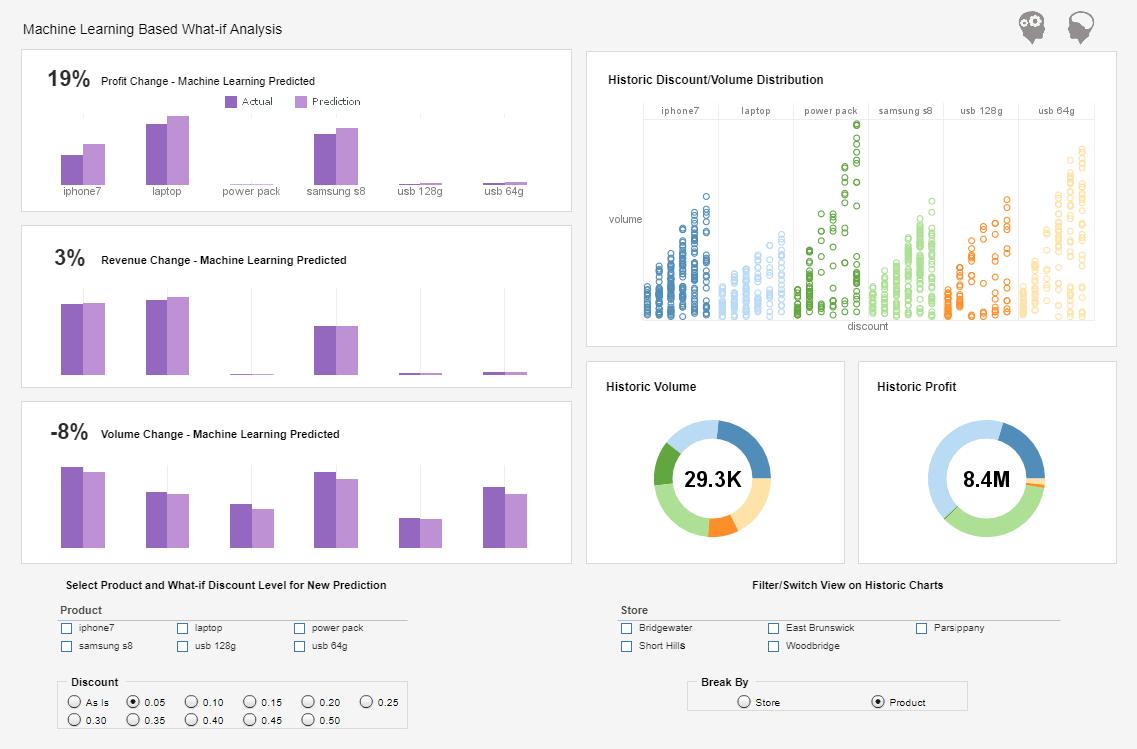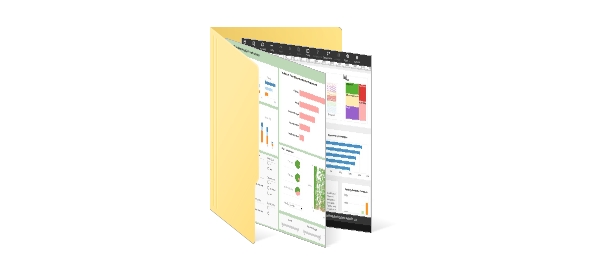Evaluate InetSoft's Web-Based BI to Replace Tableau Server
Organizations that have relied on Tableau for data visualization and dashboarding are increasingly evaluating more flexible, cost-efficient alternatives as their analytics ecosystems evolve. InetSoft’s StyleBI, an open-source business intelligence and data visualization platform, has become one of the strongest contenders in this space.
It combines the essential strengths of a modern BI solution—interactive dashboards, data mashups, and embedded analytics—with a lighter, more adaptable architecture that appeals to both enterprises and software vendors. Understanding why companies might move from Tableau to StyleBI requires looking at cost, deployment, flexibility, governance, and long-term scalability.
1. Lower Total Cost of Ownership
One of the most compelling reasons organizations explore StyleBI as a replacement for Tableau is the potential reduction in total cost of ownership (TCO). Tableau’s licensing model can become expensive as user counts grow, especially when scaling from a small analytics team to hundreds or thousands of end users. StyleBI offers a cost-effective alternative through open-source licensing and modular enterprise options. Instead of paying per user or per core, companies can deploy StyleBI broadly across departments without runaway licensing fees. This makes analytics democratization more affordable, aligning better with tight budgets in education, government, and mid-market businesses.
Beyond licensing, maintenance and infrastructure costs are also reduced. StyleBI’s web-native environment eliminates the need for heavy desktop installations or complex client-server synchronization. This simplicity lowers IT overhead while still providing centralized administration and data access controls. For many organizations, these savings are enough to justify migration by themselves.
2. Greater Flexibility in Deployment and Integration
While Tableau has a strong ecosystem for visual analytics, it is a closed platform when it comes to embedding or integrating dashboards deeply into other applications. StyleBI, by contrast, was built with openness in mind. It supports both standalone and embedded modes, making it ideal for OEM use, internal portals, or partner-facing analytics. Its web service APIs and Java-based architecture enable seamless integration with enterprise systems, while the front-end HTML5 components can be fully branded to match an existing user experience.
This flexibility extends to data connectivity. StyleBI allows users to mash up data from SQL databases, spreadsheets, web APIs, and cloud applications within a single visual layer. The platform’s Data Block™ technology gives business users the ability to join disparate sources in a governed manner without writing complex ETL pipelines. This model supports agile analytics development while maintaining security and data integrity across systems.
3. Lightweight Architecture with Enterprise Strength
Unlike Tableau Server, which can be resource-intensive to install and manage, StyleBI operates with a much smaller footprint. It can be deployed quickly on modest infrastructure—on-premises or in the cloud—while still supporting large-scale concurrent user access. Its browser-based interface eliminates version conflicts and simplifies updates, and its performance optimizations make it suitable for both interactive analysis and high-volume reporting.
This lightweight architecture benefits smaller IT teams and embedded analytics developers who need to deliver consistent uptime without extensive maintenance. Despite its simplicity, StyleBI does not sacrifice enterprise features. It includes role-based security, data caching, scheduling, and audit logging—core requirements for organizations that need accountability and compliance.
4. Data Mashup and Transformation Power
StyleBI’s most distinctive capability compared to Tableau lies in its data mashup engine. Instead of forcing analysts to rely solely on pre-modeled datasets, StyleBI lets them define virtual data layers on the fly. Users can combine transactional, warehouse, and spreadsheet data directly within the BI layer, applying transformations visually. This allows more agile data preparation and experimentation without waiting for IT to restructure data pipelines.
For teams that handle frequently changing or external data, such as financial analysts or operations managers, this flexibility shortens turnaround times dramatically. It also minimizes redundancy since mashups can be reused and shared across reports and dashboards.
5. Embeddability and White-Labeling
Many software vendors and enterprises now prefer embedded analytics over standalone BI portals. Tableau offers limited flexibility in this area, often requiring additional licensing or API customization. StyleBI, however, was engineered for embedding. Its dashboards can be seamlessly integrated into SaaS applications, intranets, or partner portals, fully rebranded with the host’s visual identity. Developers can control access via single sign-on and automate report generation through APIs, creating a truly native analytics experience for end users.
This embeddability makes StyleBI especially attractive to ISVs, managed service providers, and digital platform developers seeking to enrich their products with dynamic analytics without adding external dependencies or recurring per-seat costs.
6. Control, Transparency, and Longevity
Tableau’s acquisition by Salesforce has introduced uncertainty about long-term roadmap direction and integration priorities. StyleBI’s open-source model offers greater transparency, control, and independence. Organizations can inspect, extend, and host their own BI stack, avoiding vendor lock-in and ensuring continuity even as corporate priorities shift. This level of autonomy is especially important for regulated industries and public sector entities that require full ownership of their analytics infrastructure.
Why Consider StyleBI as a Replacement for Power BI
Power BI has become a popular choice for data visualization and business intelligence due to its integration with Microsoft’s ecosystem and low entry cost. However, as organizations mature in their analytics journey, many encounter limitations in flexibility, scalability, and governance. InetSoft’s StyleBI presents an appealing alternative—an open, web-based BI platform designed to give enterprises and software developers more control over data access, dashboard design, and deployment models. Evaluating StyleBI as a replacement for Power BI reveals key advantages in customization, data integration, embeddability, and long-term ownership of analytics infrastructure.
1. Freedom from Platform Lock-In
Power BI is tightly coupled with Microsoft’s cloud ecosystem, particularly Azure and Office 365. While convenient for organizations already invested in that stack, this dependency can become restrictive over time. It often forces data to reside within Microsoft-controlled environments and limits connectivity to certain non-Microsoft sources unless premium gateways are purchased or managed. StyleBI, on the other hand, was built as an open, platform-agnostic solution. It runs equally well on Windows, Linux, or cloud containers and can connect to nearly any data source—SQL, NoSQL, web APIs, and spreadsheets—without requiring specialized connectors or additional licensing.
That openness means organizations retain full control over where their data is stored and how it’s processed. It also eliminates the risk of vendor lock-in, an issue that can become significant when Microsoft changes pricing tiers, licensing rules, or access limits for external users. With StyleBI, teams maintain independence while still achieving the same level of interactive analytics Power BI offers.

2. Scalable and Predictable Licensing
While Power BI appears inexpensive at first glance, its true cost rises quickly with scale. Features like advanced dataflows, paginated reporting, or enterprise governance are often gated behind higher-tier subscriptions or per-user pricing. Organizations deploying dashboards to hundreds or thousands of employees, partners, or customers can face escalating costs, particularly when embedding Power BI visuals externally. StyleBI’s licensing model is more predictable and cost-efficient. Because it’s available in an open-source edition and flexible enterprise tiers, users can deploy analytics widely without worrying about per-seat or per-session fees.
This model encourages analytics democratization—making data insights available to everyone in the organization, not just those with paid Power BI accounts. Enterprises with large external audiences, such as SaaS vendors or government agencies, especially benefit from the freedom to share dashboards openly without hidden licensing barriers.
3. Superior Embedding and White-Label Capabilities
Embedding Power BI into other software products or customer portals requires premium or embedded licenses, complex Azure configurations, and ongoing API management. These hurdles can make it difficult for product teams or internal developers to integrate analytics seamlessly into user experiences. StyleBI is designed with embedding as a native function. Dashboards, reports, and visual components can be easily integrated into web applications through lightweight APIs or iFrames. Moreover, every visual element is fully customizable and can be branded to match the host application’s look and feel.
For software vendors, this level of control is critical. White-label capabilities allow them to deliver analytics under their own brand while maintaining secure user-level access and personalized data filters. StyleBI supports single sign-on, multi-tenancy, and custom authentication mechanisms, enabling deeply integrated and secure embedded analytics without complex configuration or licensing overhead.
4. Greater Flexibility in Data Preparation and Mashups
Power BI relies heavily on pre-modeled data structures or external dataflows, which can limit agility when combining different data sources quickly. InetSoft’s StyleBI offers a more dynamic alternative through its Data Block™ mashup layer, allowing users to blend and transform data from multiple sources visually, on demand. This eliminates the need for extensive ETL scripting or IT intervention to create unified datasets. Business analysts can mix internal databases, APIs, and spreadsheets directly within the BI environment to create ad hoc views and dashboards.
This flexibility is especially valuable in organizations where data is distributed across systems like Salesforce, SAP, Google Sheets, and custom SQL databases. Rather than maintaining multiple data pipelines, StyleBI lets users construct virtual joins and aggregations instantly, resulting in faster report creation and fewer bottlenecks between IT and business teams.
5. Lightweight Web Architecture and Open Standards
Power BI’s reliance on desktop authoring tools and Azure services can complicate deployment and maintenance, especially for organizations outside the Microsoft ecosystem. StyleBI runs entirely in a web environment, requiring no local installations or proprietary plug-ins. Its HTML5-based architecture delivers dashboards to any browser or device with full interactivity, and updates can be applied centrally without disrupting end users.
This lightweight approach reduces the operational footprint and simplifies version control across the organization. Because it’s built on open standards like Java and RESTful APIs, StyleBI can be easily integrated into existing IT infrastructures, DevOps pipelines, and data security frameworks. For enterprises looking to streamline governance and minimize administrative burden, StyleBI’s web-first design provides clear advantages over Power BI’s hybrid model.
6. Transparent, Customizable, and Future-Proof
Power BI’s roadmap and API access are dictated entirely by Microsoft, leaving customers dependent on its product decisions and release schedules. StyleBI’s open architecture offers transparency and long-term flexibility. Organizations can customize functionality, extend visual components, and even host the entire analytics environment on their own infrastructure. This level of control ensures stability and continuity, even as technology landscapes change.
For businesses seeking an alternative to Power BI that prioritizes openness, scalability, and embedding flexibility, StyleBI provides a forward-looking solution. It combines the sophistication of enterprise BI tools with the agility of open-source technology, enabling full ownership of both the analytics platform and the insights it delivers. By replacing Power BI with StyleBI, organizations gain independence, lower costs, and a more adaptable framework for data-driven innovation.



